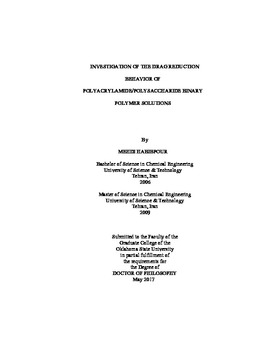| dc.contributor.advisor | Clark, Peter E. | |
| dc.contributor.author | Habibpour, Mehdi | |
| dc.date.accessioned | 2018-03-13T18:15:43Z | |
| dc.date.available | 2018-03-13T18:15:43Z | |
| dc.date.issued | 2017-05 | |
| dc.identifier.uri | https://hdl.handle.net/11244/54532 | |
| dc.description.abstract | In this study, rheological behavior and drag reduction (DR) efficiency of various polymer solutions were investigated. The studied polymer solutions included anionic polyacrylamide (HPAM), xanthan gum (XG), guar gum (GG) and binary polyacrylamide/polysaccharide mixtures. Polyacrylamide is a long-chain flexible molecule, which acts as an efficient drag reducer in the solution. Mechanical degradation at turbulent flow is a drawback associated with polyacrylamide, which results in DR decline. Guar gum and xanthan gum are known to exhibit DR properties and high resistance to shear degradation. In this research, the DR behavior of polymer solutions were investigated in closed flow loop and rheological characterization was utilized to assess the flow properties of the solutions. Initially, the DR behaviors of single polymer solutions were determined. It was found that concentration directly effected viscosity and DR efficiency of the polymer solutions. Among the studied HPAM solutions, the greatest efficiency belonged to 1000 wppm solution (68%). All HPAM solutions suffered from mechanical degradation and loss DR efficiency. On the other hand, both XG and GG solutions exhibited good resistance to shear degradation (< 5% decline). DR efficiency of the solutions were in the following order: HPAM > XG > GG. In order to benefit from the advantages of both polymer types, binary polyacrylamide/polysaccharide solutions were prepared and tested. No synergism was observed in HPAM/GG solutions even at high concentration (C = 1150 wppm). Dilute HPAM/XG solutions (C < 300 wppm) initially exhibited greater DR efficiency (40% and 55%) than XG solutions, but due to shear degradation, DR% declined. Increasing the concentration of XG in binary HPAM/XG solutions (C > 300 wppm), improved both DR efficiency and shear stability (6-8% decline after shearing for 2 hours) of the solutions. Another issue associated with HPAM is the sensitivity to the presence of salt ions in the solution. Addition of 2% KCl in the solution reduced the DR% of 1000 wppm solution from 68% to10%. The effect of salt on concentrated HPAM/XG solutions was verified. It was found that presence of XGin binary solutions reduced the negative effect of salt ions on HPAM molecules. | |
| dc.format | application/pdf | |
| dc.language | en_US | |
| dc.rights | Copyright is held by the author who has granted the Oklahoma State University Library the non-exclusive right to share this material in its institutional repository. Contact Digital Library Services at lib-dls@okstate.edu or 405-744-9161 for the permission policy on the use, reproduction or distribution of this material. | |
| dc.title | Investigation of the drag reduction behavior of polyacrylamide/polysaccharide binary polymer solutions | |
| dc.contributor.committeeMember | Hareland, Geir | |
| dc.contributor.committeeMember | Aichele, Clint P. | |
| dc.contributor.committeeMember | Pashin, Jack C. | |
| osu.filename | Habibpour_okstate_0664D_15089.pdf | |
| osu.accesstype | Open Access | |
| dc.type.genre | Dissertation | |
| dc.type.material | Text | |
| thesis.degree.discipline | Chemical Engineering | |
| thesis.degree.grantor | Oklahoma State University | |
